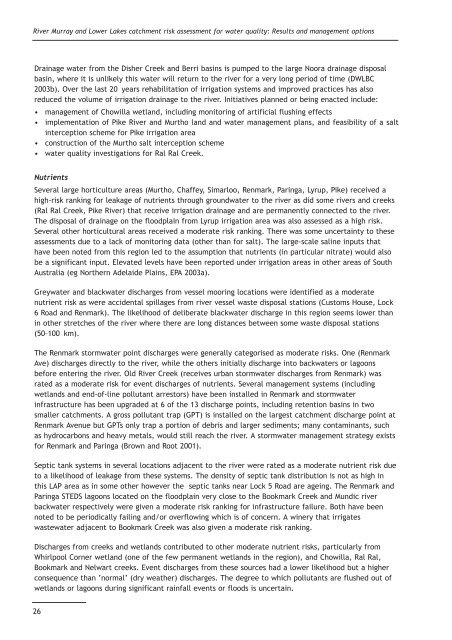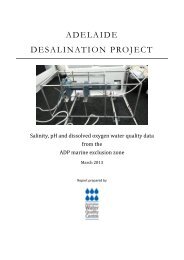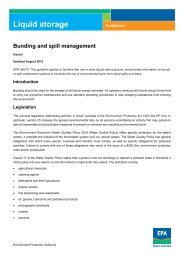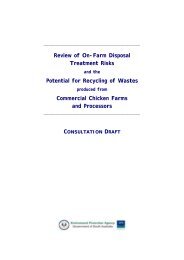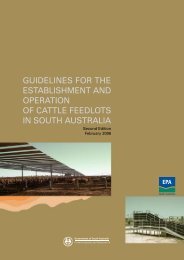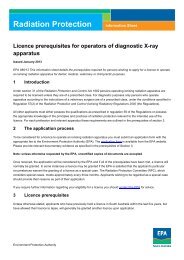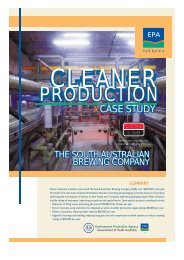2 Renmark to border LAP area assessment - EPA - Sa.gov.au
2 Renmark to border LAP area assessment - EPA - Sa.gov.au
2 Renmark to border LAP area assessment - EPA - Sa.gov.au
You also want an ePaper? Increase the reach of your titles
YUMPU automatically turns print PDFs into web optimized ePapers that Google loves.
River Murray and Lower Lakes catchment risk <strong>assessment</strong> for water quality: Results and management options<br />
Drainage water from the Disher Creek and Berri basins is pumped <strong>to</strong> the large Noora drainage disposal<br />
basin, where it is unlikely this water will return <strong>to</strong> the river for a very long period of time (DWLBC<br />
2003b). Over the last 20 years rehabilitation of irrigation systems and improved practices has also<br />
reduced the volume of irrigation drainage <strong>to</strong> the river. Initiatives planned or being enacted include:<br />
• management of Chowilla wetland, including moni<strong>to</strong>ring of artificial flushing effects<br />
• implementation of Pike River and Murtho land and water management plans, and feasibility of a salt<br />
interception scheme for Pike irrigation <strong>area</strong><br />
• construction of the Murtho salt interception scheme<br />
• water quality investigations for Ral Ral Creek.<br />
Nutrients<br />
Several large horticulture <strong>area</strong>s (Murtho, Chaffey, Simarloo, <strong>Renmark</strong>, Paringa, Lyrup, Pike) received a<br />
high-risk ranking for leakage of nutrients through groundwater <strong>to</strong> the river as did some rivers and creeks<br />
(Ral Ral Creek, Pike River) that receive irrigation drainage and are permanently connected <strong>to</strong> the river.<br />
The disposal of drainage on the floodplain from Lyrup irrigation <strong>area</strong> was also assessed as a high risk.<br />
Several other horticultural <strong>area</strong>s received a moderate risk ranking. There was some uncertainty <strong>to</strong> these<br />
<strong>assessment</strong>s due <strong>to</strong> a lack of moni<strong>to</strong>ring data (other than for salt). The large-scale saline inputs that<br />
have been noted from this region led <strong>to</strong> the assumption that nutrients (in particular nitrate) would also<br />
be a significant input. Elevated levels have been reported under irrigation <strong>area</strong>s in other <strong>area</strong>s of South<br />
Australia (eg Northern Adelaide Plains, <strong>EPA</strong> 2003a).<br />
Greywater and blackwater discharges from vessel mooring locations were identified as a moderate<br />
nutrient risk as were accidental spillages from river vessel waste disposal stations (Cus<strong>to</strong>ms House, Lock<br />
6 Road and <strong>Renmark</strong>). The likelihood of deliberate blackwater discharge in this region seems lower than<br />
in other stretches of the river where there are long distances between some waste disposal stations<br />
(50–100 km).<br />
The <strong>Renmark</strong> s<strong>to</strong>rmwater point discharges were generally categorised as moderate risks. One (<strong>Renmark</strong><br />
Ave) discharges directly <strong>to</strong> the river, while the others initially discharge in<strong>to</strong> backwaters or lagoons<br />
before entering the river. Old River Creek (receives urban s<strong>to</strong>rmwater discharges from <strong>Renmark</strong>) was<br />
rated as a moderate risk for event discharges of nutrients. Several management systems (including<br />
wetlands and end-of-line pollutant arres<strong>to</strong>rs) have been installed in <strong>Renmark</strong> and s<strong>to</strong>rmwater<br />
infrastructure has been upgraded at 6 of the 13 discharge points, including retention basins in two<br />
smaller catchments. A gross pollutant trap (GPT) is installed on the largest catchment discharge point at<br />
<strong>Renmark</strong> Avenue but GPTs only trap a portion of debris and larger sediments; many contaminants, such<br />
as hydrocarbons and heavy metals, would still reach the river. A s<strong>to</strong>rmwater management strategy exists<br />
for <strong>Renmark</strong> and Paringa (Brown and Root 2001).<br />
Septic tank systems in several locations adjacent <strong>to</strong> the river were rated as a moderate nutrient risk due<br />
<strong>to</strong> a likelihood of leakage from these systems. The density of septic tank distribution is not as high in<br />
this <strong>LAP</strong> <strong>area</strong> as in some other however the septic tanks near Lock 5 Road are ageing. The <strong>Renmark</strong> and<br />
Paringa STEDS lagoons located on the floodplain very close <strong>to</strong> the Bookmark Creek and Mundic river<br />
backwater respectively were given a moderate risk ranking for infrastructure failure. Both have been<br />
noted <strong>to</strong> be periodically failing and/or overflowing which is of concern. A winery that irrigates<br />
wastewater adjacent <strong>to</strong> Bookmark Creek was also given a moderate risk ranking.<br />
Discharges from creeks and wetlands contributed <strong>to</strong> other moderate nutrient risks, particularly from<br />
Whirlpool Corner wetland (one of the few permanent wetlands in the region), and Chowilla, Ral Ral,<br />
Bookmark and Nelwart creeks. Event discharges from these sources had a lower likelihood but a higher<br />
consequence than ‘normal’ (dry weather) discharges. The degree <strong>to</strong> which pollutants are flushed out of<br />
wetlands or lagoons during significant rainfall events or floods is uncertain.<br />
26


